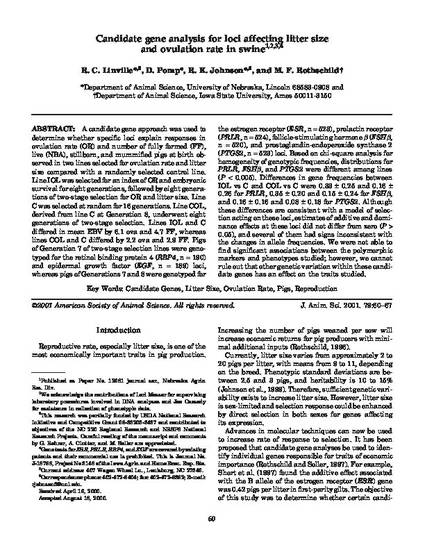
A candidate gene approach was used to determine whether specific loci explain responses in ovulation rate (OR) and number of fully formed (FF), live (NBA), stillborn, and mummified pigs at birth observed in two lines selected for ovulation rate and litter size compared with a randomly selected control line. Line IOL was selected for an index of OR and embryonic survival for eight generations, followed by eight generations of two-stage selection for OR and litter size. Line C was selected at random for 16 generations. Line COL, derived from line C at Generation 8, underwent eight generations of two-stage selection. Lines IOL and C differed in mean EBV by 6.1 ova and 4.7 FF, whereas lines COL and C differed by 2.2 ova and 2.9 FF. Pigs of Generation 7 of two-stage selection lines were genotyped for the retinol binding protein 4 (RBP4, n = 190) and epidermal growth factor (EGF, n = 189) loci, whereas pigs of Generations 7 and 8 were genotyped for the estrogen receptor (ESR, n = 523), prolactin receptor (PRLR, n = 524), follicle-stimulating hormone beta (FSHbeta, n = 520), and prostaglandin-endoperoxide synthase 2 (PTGS2, n = 523) loci. Based on chi-square analysis for homogeneity of genotypic frequencies, distributions for PRLR, FSHbeta, and PTGS2 were different among lines (P < 0.005). Differences in gene frequencies between IOL vs C and COL vs C were 0.33 +/- 0.25 and 0.16 +/- 0.26 for PRLR, 0.35 +/- 0.20 and 0.15 +/- 0.24 for FSHbeta, and 0.16 +/- 0.16 and 0.08 +/- 0.18 for PTGS2. Although these differences are consistent with a model of selection acting on these loci, estimates of additive and dominance effects at these loci did not differ from zero (P > 0.05), and several of them had signs inconsistent with the changes in allele frequencies. We were not able to find significant associations between the polymorphic markers and phenotypes studied; however, we cannot rule out that other genetic variation within these candidate genes has an effect on the traits studied.
Available at: http://works.bepress.com/max-rothschild/28/

This is an article from Journal of Animal Science 79 (2001): 60, doi:/2001.79160x. Posted with permission.